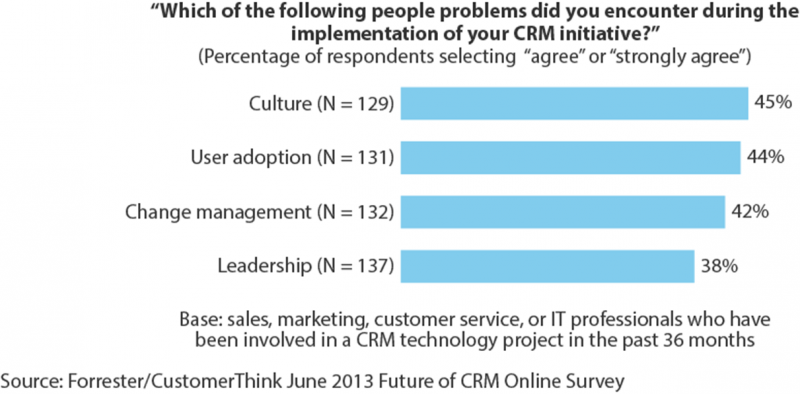How To Succeed With CRM: The Critical Success Factors, Part 3
To succeed in the age of the customer, IT leaders that that support “front-office” business processes cannot afford failed technology initiatives. In recent blog posts, I have been sharing the results of a recent Forrester survey of practioners to define and quantify the best practices for CRM success.
Working in partnership with CustomerThink, Forrester collected opinions from over 600 individuals who had been involved in a CRM technology project as a business professional in sales, marketing, customer service, or IT.
A few weeks ago, I reported that our data show that CRM technology deployments require a balanced and multifaceted approach that addresses four critical fundamentals: process, people, strategy, and technology.
More than two-fifths (42%) stated that their problems with CRM were the result of “people” issues such as slow user adoption, inadequate attention paid to change management and training, and difficulties in aligning the organizational culture with new ways of working. These can become key roadblocks to the effective use of CRM technology solutions to achieve better business outcomes.
More the specifically, the top people challenges to implementing a CRM solution include cultural resistance to adopting new ways of working (45%), difficulties in achieving user adoption (44%), insufficient planning and attention given to change management (42%), and inadequate leadership (38%).

What does this mean for you?
- Use continuous improvement to soften culture shock. Successful CRM requires that an organization learn and accept new business processes and supporting technologies, which is never easy. As a manager of IT quality at a public sector company put it, “Our greatest difficulty was changing the culture of our users.” Use quick wins to gain support for the new CRM system and continuous improvement to keep interest high.
- Overcome adoption issues by letting users influence functionality. New CRM processes and technologies that do not have a clear benefit for users and that are not properly socialized will not be adopted. A CRM architect at a media, entertainment, and leisure firm told us that “end user adoption is always difficult, especially with our sales team.” Enterprises should ensure that users have opportunities to influence application functionality and enhancements.
- Plan carefully to facilitate changes in management and employee behaviors. The tone for a customer-centric culture, and the need to adopt new processes and tools to serve customers more effectively, is set by the top executives of an organization. Employees look at the behaviors of the senior leadership team to determine which activities are valued and which aren’t. As the CRM manager of a business services company told us, “Our greatest problem was lack of buy-in from management.”
Traditionally, IT organizations have existed to support internal operations but in today’s world, the technology leaders must play a key role when it comes to delivering solutions that support better external customer experiences. With business partners in need of help, it’s up to technology leaders to help identify and deliver solutions that will give their companies a competitive edge.
We will explore these topics on October 17 and 18 at the Forrester Forum for Application Development & Delivery Professionals. The Forum will showcase the top technologies, skills and practices you will need to take a leadership role in the development of world-class customer experiences at your company.